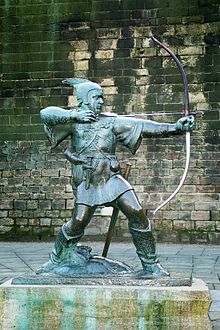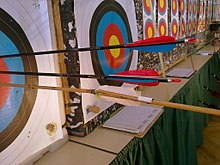Robin Hood
![]()
This article is about the heroic figure Robin Hood. For other meanings, see Robin Hood (disambiguation).
Robin Hood [ˌrɒbɪn hʊd] is the central hero of several late medieval to early modern English ballad cycles, which over the centuries formed into the saga we know today. The plots of the ballads were continually rewritten and developed, and new ballads were also invented. In the oldest written sources from the middle of the 15th century, for example, Robin Hood is still portrayed as a dangerous highwayman of simple origin who prefers to rob greedy clergymen and noblemen. In the course of his confrontations with enemies, he also engages in medieval cruel practices. Later he is portrayed more and more positively. Poetry makes him a dispossessed Anglo-Saxon nobleman and an Anglo-Saxon patriot fighting the Normans. Over the course of the 16th and 17th centuries, the character also transforms into a champion of social justice, taking from the rich and giving to the poor. The existence of Robin Hood as a real historical figure is not proven.
According to the medieval ballads, Robin Hood plies his robber trade with Merry Men, "merry companions," including Little John, Friar Tuck, and Will Scarlet. They are outlaws hiding from the law - in the guise of the Sheriff of Nottingham - in Sherwood Forest and Barnsdale Forest. Later, they are joined by Robin's romantic love for Maid Marian and the bard Allan a Dale. The adventurous material has remained popular to this day. It was taken up in dramas, novels and operas, since the 19th century also in juvenile literature and since the 20th century also in various films and television series.

Robin Hood memorial in front of Nottingham Castle
Other use of the name
- The name of the environmental protection organisation Robin Wood is based on the figure of Robin Hood.
- A hit in archery and darts which "impales" an arrow already stuck in the target is called a Robin Hood shot.
- The Robin-Hood index is used to measure income inequality based on the Lorenz curve.
- The Robin Hood tax is a proposed financial transaction tax.
- "Robin Hood" becomes a common term for disinterested robbers or, more generally, for actions aimed at social redistribution.

Slashed aluminum arrow after a Robin Hood shot

Robin Hood shot
Questions and Answers
Q: Who is Robin Hood?
A: Robin Hood is a legendary folk hero from England during the Middle Ages who is known for stealing from the rich and giving to the poor.
Q: Where did Robin Hood live?
A: Robin Hood lived in Sherwood Forest close to Nottingham, England.
Q: Who were Robin Hood's enemies?
A: Robin Hood had two powerful enemies: Prince John, who was ruling as king while his brother, King Richard was away fighting in the Crusades, and the corrupt Sheriff of Nottingham.
Q: Why were Prince John and the Sheriff of Nottingham Robin Hood's enemies?
A: Prince John and the Sheriff of Nottingham were Robin Hood's enemies because they abused their powers and took money from poor people.
Q: What did Robin Hood do to help the poor?
A: Using his intelligence and archery skills, Robin Hood stole money from the rich and returned it to the poor.
Q: Who were The Merry Men?
A: The Merry Men were a group of followers who accompanied Robin Hood on his adventures. In the earliest stories, The Merry Men consisted of Little John, Much the Miller's Son, and Will Scarlet. Later stories added Friar Tuck, Alan-a-Dale, and Maid Marian.
Q: What kind of stories have been told about Robin Hood?
A: Many different versions of Robin Hood stories have been told over the centuries. They include books, plays, movies, and cartoons.
Search within the encyclopedia